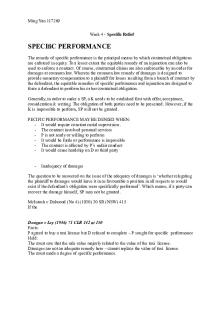Week 5 - weekly PDF

| Title | Week 5 - weekly |
|---|---|
| Author | JiaCong Xu |
| Course | Ethics Law and Justice |
| Institution | University of Technology Sydney |
| Pages | 2 |
| File Size | 88.9 KB |
| File Type | |
| Total Downloads | 71 |
| Total Views | 151 |
Summary
weekly...
Description
S2020 Ethics, Law and Justice ONLINE
Seminar 5: Access to Justice (Economic Issues) 1. Readings Littrich and Murray textbook:
Ch 16 - Access to Justice - Meeting the Costs, pp 344-369
The Reader:1
Community Law Australia (2012), ‘Unaffordable and out of reach: the problem of access to the Australian legal system’
2. Questions Different Forms of Legal Payment 1. Time billing is the most common form of payment in the legal profession. What are the strengths and weaknesses of time billing (for lawyers and clients)? 2. ‘No Win No Fee’ sounds appealing for many potential clients. What are the strengths and weaknesses of ‘no win no fee’ billing (for lawyers and clients)? 3. Contingency fees are common in the United States, but are illegal in Australia (Uniform Law s 183). Why are they illegal? What are the strengths and weaknesses of: a. contingency fee payments? b. litigation lending funds in accessing justice. 4. In recent years, more lawyers are experimenting with flat fees. What are the strengths and weaknesses of ‘flat fees’ (for lawyers and clients)?
1 This is the ‘ELJ Spring 2020 Seminar Reading Materials’ PDF. You’ll find it in: UTSOnline >
Ethics, Law and Justice > Seminar Materials.
Alternatives for those who cannot afford legal services 5. What is a class (or representative) action? In what way could a Class action, or a test case, increase access to legal services for those who may not otherwise be able to afford the cost of litigation? Give some examples. What are the advantages and disadvantages of these types of cases for lawyers and clients? Do any ethical issues arise? 6. When and how was Legal Aid developed in Australia? What do you understand about the availability of Legal Aid in general in NSW? Can lawyers in private practice conduct Legal Aid work? How difficult is it to pass the matter, merit and means tests? (See Legal Aid NSW home page - http://www.legalaid.nsw.gov.au/) 7. What is the history, role and purpose of Community Legal Centres (CLCs)? How are they funded? Give some examples. (See CLC NSW homepage - http://www.clcnsw.org.au/) 8. ‘Pro Bono Publico’ means ‘for the public good.’ To what extent do lawyers owe a duty to the public to facilitate ‘access to justice’? What are the arguments for and against lawyers being required to undertake Pro Bono work? To what extent should Commonwealth and State governments subsidise legal services? Consider the distributive justice approaches discussed in Week 4. 9. “Unless you are a millionaire or a pauper, the cost of going to court to protect your rights is beyond you.” - George Brandis (Commonwealth Attorney-General)2 What does this quote mean? Do you agree? 10. What is ‘Alternative Dispute Resolution’? Should the word ‘Alternative’ be in ‘Alternative Dispute Resolution’? 11. What is the role of negotiation, mediation, arbitration and ADR in ethical legal practice?
2 ‘Lack of access an impending social crisis’, The Australian, 1 June 2012...
Similar Free PDFs

Week 5 - weekly
- 2 Pages

7 - weekly submissions , week 5
- 2 Pages

Week 4 - Weekly note
- 5 Pages

Weekly Reflection- Week 6
- 2 Pages

Titas Weekly Quiz 5
- 2 Pages

Week 5 - Week 5
- 7 Pages

Quiz 5 - Weekly Quiz
- 6 Pages

Weekly Quiz 5 Solutions
- 2 Pages

IE Week 2 - Weekly Assignment
- 1 Pages

Tax Law Week 8 - weekly
- 4 Pages

Tax Law Week 10 - weekly
- 4 Pages

Week 1 - Weekly Discussion 1
- 2 Pages

WEEK 5 - week 5 assignment
- 1 Pages
Popular Institutions
- Tinajero National High School - Annex
- Politeknik Caltex Riau
- Yokohama City University
- SGT University
- University of Al-Qadisiyah
- Divine Word College of Vigan
- Techniek College Rotterdam
- Universidade de Santiago
- Universiti Teknologi MARA Cawangan Johor Kampus Pasir Gudang
- Poltekkes Kemenkes Yogyakarta
- Baguio City National High School
- Colegio san marcos
- preparatoria uno
- Centro de Bachillerato Tecnológico Industrial y de Servicios No. 107
- Dalian Maritime University
- Quang Trung Secondary School
- Colegio Tecnológico en Informática
- Corporación Regional de Educación Superior
- Grupo CEDVA
- Dar Al Uloom University
- Centro de Estudios Preuniversitarios de la Universidad Nacional de Ingeniería
- 上智大学
- Aakash International School, Nuna Majara
- San Felipe Neri Catholic School
- Kang Chiao International School - New Taipei City
- Misamis Occidental National High School
- Institución Educativa Escuela Normal Juan Ladrilleros
- Kolehiyo ng Pantukan
- Batanes State College
- Instituto Continental
- Sekolah Menengah Kejuruan Kesehatan Kaltara (Tarakan)
- Colegio de La Inmaculada Concepcion - Cebu


